The world's largest Navajo Rug
In 1932 Lorenzo Hubbell of the famous Hubbell Trading Post network commissioned Sam and Julia Joe to weave the world's largest Navajo Rug for promotional purposes. It has not been seen in public in over 50 years. Allan Affeldt purchased the rug in 2012. He donated it to the Winslow Art Trust and it will be displayed at the Route 66 Art Museum at La Posada Hotel in Winslow, Arizona. On this day the descendants of the Joe family have been invited to a private reunion at La Posada. This event is especially touching because in attendance is Emma Joe who as a child carded wool for two years to help make the rug. This will be the first time most of the members of the Joe family will see and touch the rug.
Filmed and edited by David Herzberg
What is the Purpose of a Wedding Vase?
Teresita Naranjo relayed to author Betty LeFree the following explanation of the wedding vase:
“After a period of courtship, a boy and girl decide to get married, but they cannot do so until certain customs have been observed. The boy must first call all his relatives together to tell them that he desires to be married to a certain girl. If the relatives agree, two or three of the oldest men are chosen to call on the parents of the girl. Here they pray according to Indian custom and then the oldest man will tell the parents of the girl what their mission is. The parents never give a definite answer at this time—they just say they will let the boy’s family know their decision.
“About a week later, the girl calls a meeting of her relatives. The family then decides what answer should be given. If the answer is ‘no,’ that is the end of it, but if the answer is ‘yes,’ the oldest men in her family are delegated to go to the boy’s home to give their answer and to tell the boy on what day he can come to receive his bride-to-be.
“Now the boy must find a godmother and a godfather. The godmother immediately starts making the wedding vase so that it will be finished by the time the girl is to be received. The godmother also takes some of the stones which are designated as ‘holy’ and dips them into water to make the ‘holy water’ with which the vase is filled for the day of the reception. The boy also must notify all of his relatives on what day the girl will receive him so that they will be able buy gifts for the girl.
“The reception day finally comes and the godmother and the godfather lead the procession of the boy’s relatives to the home of the girl. The groom-to-be is the last in line and must stand at the door of the girl’s home until the gifts have been received and opened by the girl.
“The bride and groom now kneel in the middle of the room with the boy’s relatives and the girl’s relatives praying all around them. After the prayers, the godmother places the wedding vase in front of the bride and groom.
“The bride then drinks out of one side of the wedding vase and the groom drinks from the other. Then the vase is passed to all in the room—the men drinking from one side and the women from the other.
“After the ritual of drinking the ‘holy water’ and the prayers, the girl’s family feeds all the boy’s relatives and a date is set for the church wedding. The wedding vase is now put aside until after the church wedding.
“After the church wedding, the wedding vase is again filled with any drink the family may choose and all the family drinks in the traditional manner—women on one side, men on the other.
“The wedding vase has now served its ceremonial function and is now given to the young couple as a good luck piece.”
Condition: this Santa Clara Pottery Black Wedding Vessel with Bear Paws by Margaret Tafoya is in excellent condition
Provenance: sold to a client from Santa Fe from whom we now have it back to sell
Reference: Santa Clara Pottery Today by Betty LeFree
HOW TO MEASURE YOUR WRIST FOR BRACELET SIZE
HOW TO MEASURE YOUR WRIST FOR BRACELET SIZE
Measure your wrist with a flexible tape measurement or a strip of paper just below the wrist bone, where you would normally wear the bracelet.
Option: If you are using a plain strip of paper, mark your size with a pen or pencil then use a ruler to measure the length. That would be your wrist size.
Tip: Do you want a snug or loose fit? Well, that really will vary between everyone. If you are buying a delicate bracelet, we suggest doing a snug fit. Most other bracelets should have a comfort fit except when buying large or thick cuffs or bangles. It's best to buy large bracelets with a loose fit so you don't feel like you are suffocating your wrist, or it will be worn over clothing.
| Fitting Style | Add inch(es) to wrist size |
| Snug Fit | Add 1/4" to 1/2" |
| Comfort Fit | Add 3/4" to 1" |
| Loose Fit | Add 1 1/4" |
Adobe Gallery Staff Favorites, Volume 2: Mary Says
This month, we're using our blog to highlight the artworks that our staff members love. There are many great artworks here, of course, so we've asked each person to choose their favorite pieces. Here's another edition of "Mary Says"—two artworks chosen by Mary.
Life certainly is different these days. As I remain sequestered in my home instead of making the weekly drive to Santa Fe, something is missing in my life. I really miss my coworkers. I miss talking to clients and sharing my love of the material that Al has in the gallery. Luckily for me and for you, the fantastic, amazing Adobe Gallery website is still here. At least I can look at the pots, the paintings, the jewelry and take in their beauty remotely. 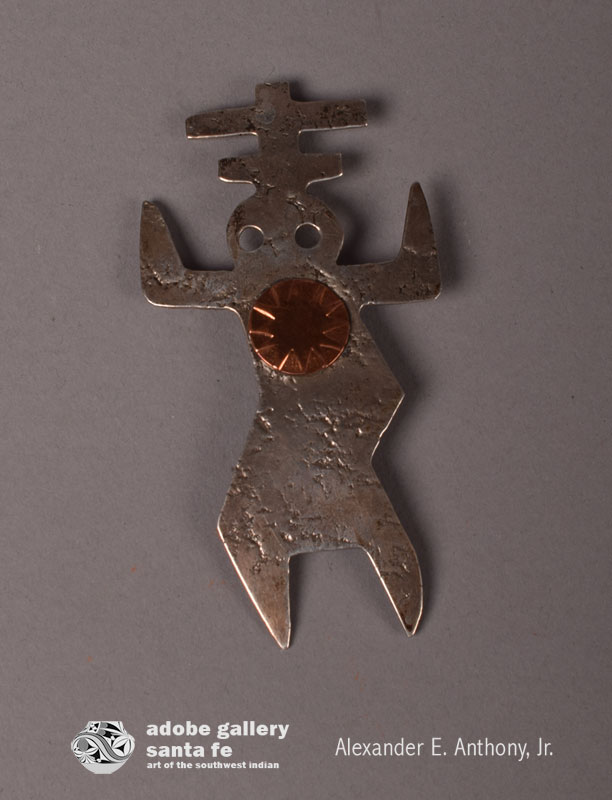
Every morning I wake up and the website is one of the first things I look at. It is my portal to normalcy, it is my pathway to balance and beauty. So, continuing in that vein, I thought I would share with you some of my favorite pieces, things that I especially like, for personal reasons. These are not descriptions, or biographies, more of just what I like and why I like them and why I think others should be aware of their special qualities.
This morning, I am going to talk about jewelry. Anyone who knows me knows that I love jewelry. When new collections come in, I can’t wait to look at the pieces, hold them and research them.
One of the most intriguing artists whose work we have in the jewelry case is Jan Loco. When I first wrote about these pieces, (items C4270A and C4270B, or just click the photos included here) I kept wanting to write, “These are just so cool. She pounded the silver out with rocks! How did she do that? The dancers seem to move. These are unique, no one else is making jewelry like this.”
Besides these pieces being one-of a kind, you should also know that Jan Loco is not making jewelry anymore. One of the most acclaimed Native jewelers, whose work was published in books, just vanished from the art scene. From a collecting perspective, there is just not that much of her work out there. So visit the pieces and see if you agree with me. These would go really nicely as a pin to hold a scarf in place. The pins are definitely wearable, as well as collectible, and like I said, “They are really cool!” 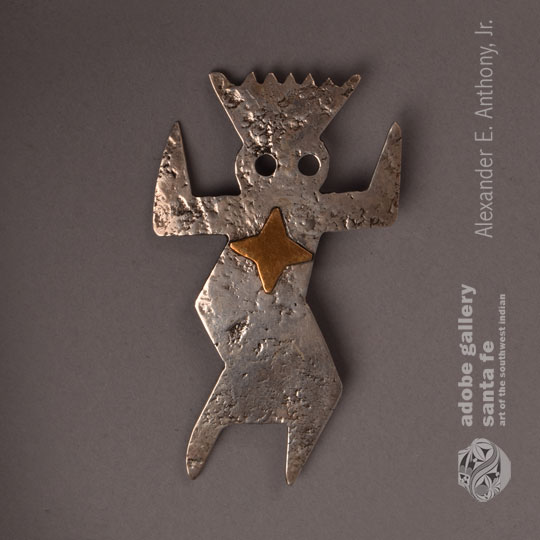
Read More about Apache Jeweler Jan Loco and these two Pins
I have a few more pieces that I think may be worth looking at in a different light. Next time, I will share with you my feelings about a pretty special concho belt.
Read Last Week's "Staff Favorites" Blog Entry
Adobe Gallery Staff Favorites, Volume One: Mike Likes
This week, we're using our blog to highlight the artworks that our staff members love. There are many great artworks here, of course, so we've asked each person to choose their favorite pieces. First up is "Mike Likes..."—four artworks chosen by Michael.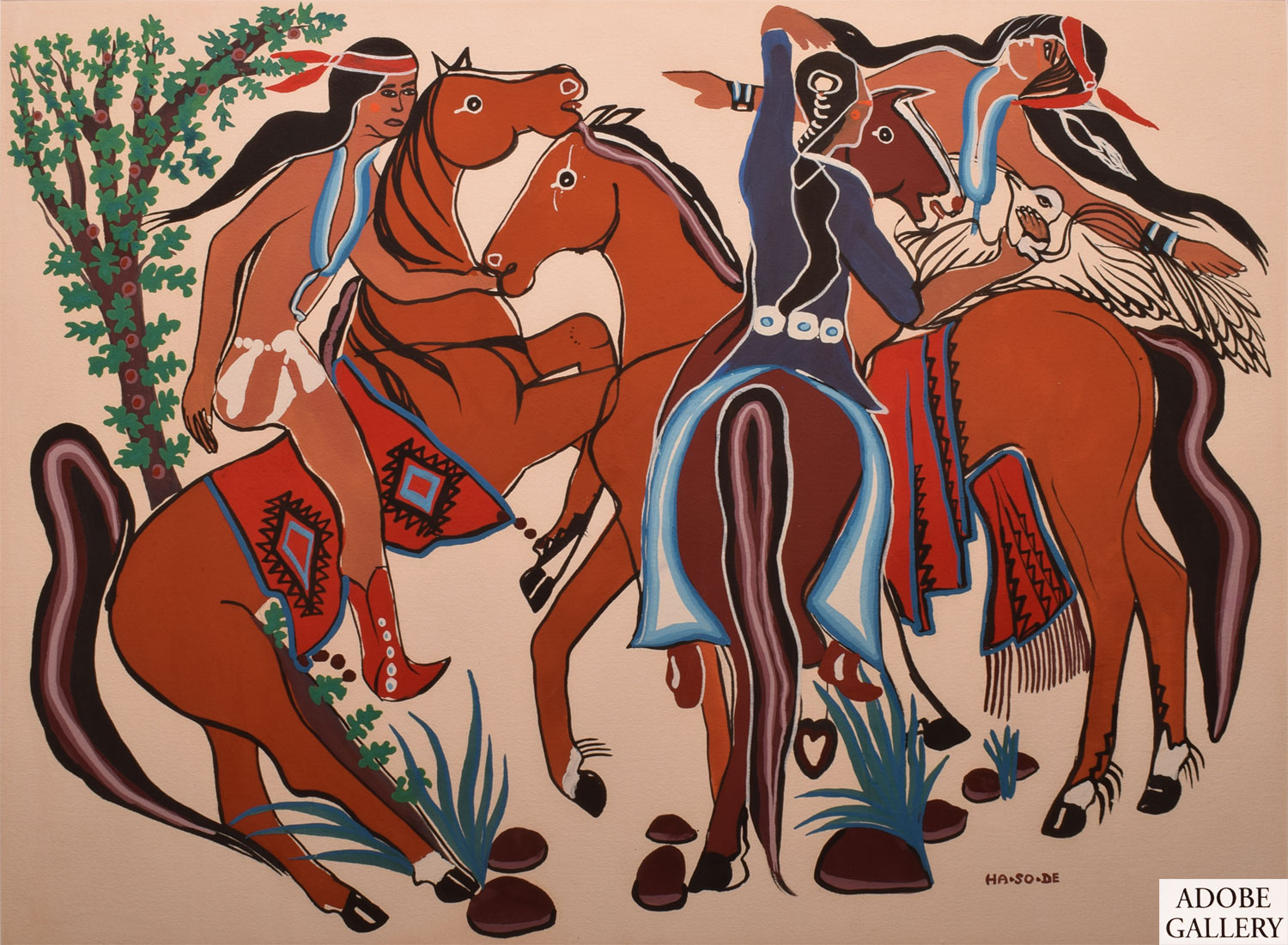
During my time at Adobe Gallery, I've had the pleasure of studying and writing about hundreds of Native paintings. I can say, without question, that my personal favorites are the works of Narciso Abeyta "Ha So De." He was a true individualist who painted Native imagery in a uniquely expressive style. Every one of his paintings feels alive to me. I'm always very excited when a Ha So De painting makes its way to the gallery. I usually hang them near my desk (one of the great perks of the job) and enjoy them as frequently as possible before sending them off to their new owners. Ha So De's paintings often feature mythological imagery and use surreal colors, but this painting of a chicken pull is grounded in the physical world. The colors are naturalistic, and the action is brilliantly executed. I also enjoy being able to talk to Ha So De's talented and successful son when I need information about where, when and why these paintings were created.
Read more about Ha So De's Chicken Pull painting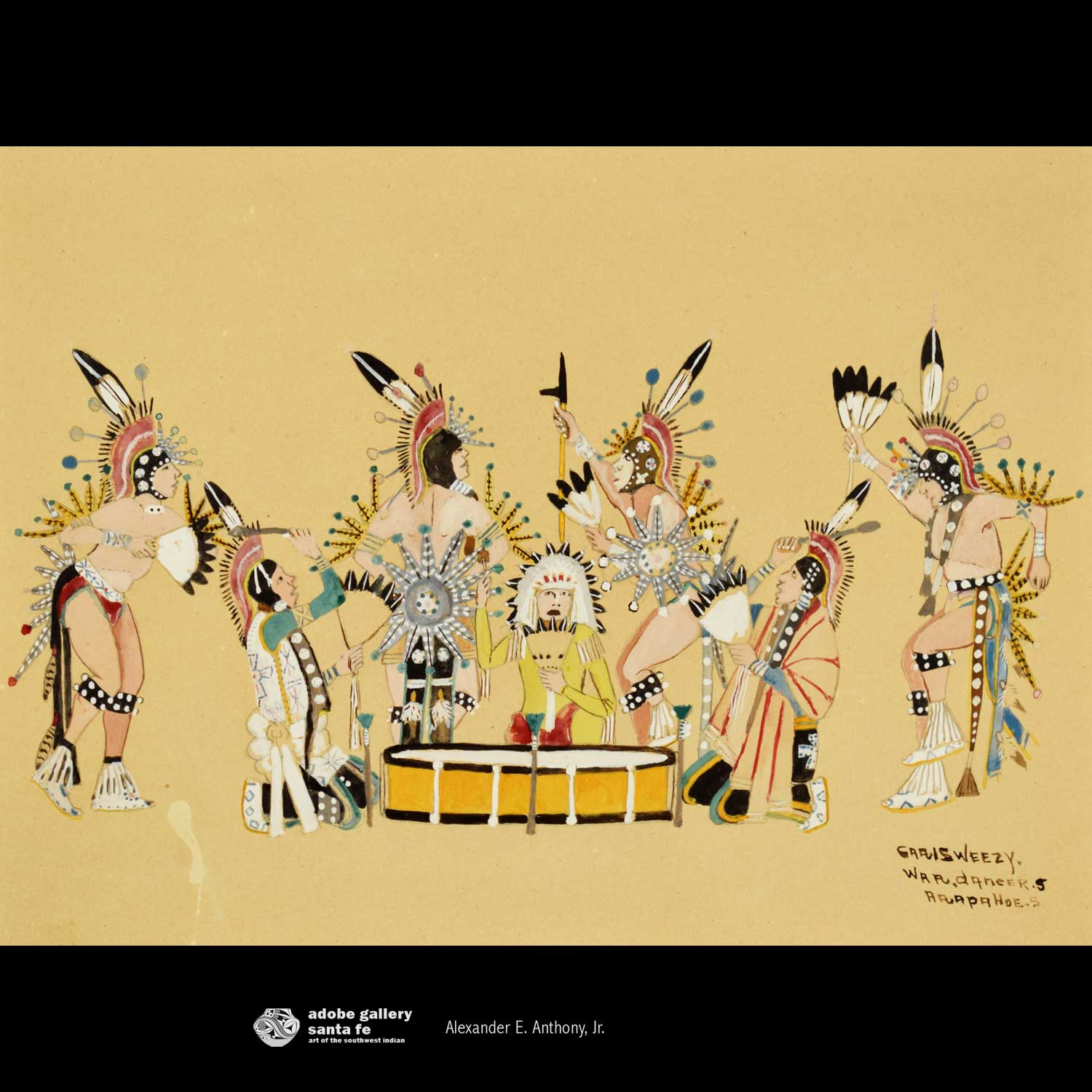
A few years, a client consigned to us a large collection of paintings by early Arapaho artist Carl Sweezy. We deal mostly in Pueblo and Diné art, so it was fun to change it up and learn about an early Plains artist. This painting was my favorite of the collection. All of the color and movement make for an exciting image, and I love the way the figures are arranged around the drum. We like to say that certain pieces have "the magic"—"the magic" being an appeal that is hard to describe using technical terms. This piece most definitely has the magic. I think it is one of the best paintings we have in our inventory right now.
Read more about "War Dancers Arapahoes"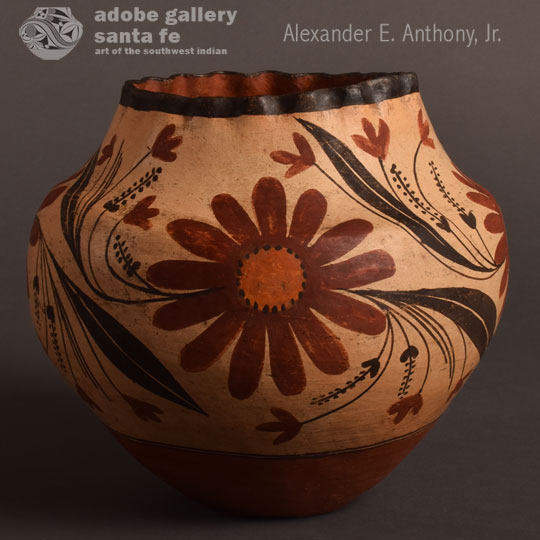
This little Laguna jar is incredibly charming. The colors are gorgeous, and the fluted rim is wonderful. It leans to one side just a bit, which you'll see when you look at the rim from certain angles. This doesn't bother me one bit. I actually really like these imperfections, as they remind me that the pot was made by the hand of a human being. I understand and appreciate that way that many of today's potters achieve near-perfect symmetry in their work, but I love the different sort of perfection acheived by this historic Laguna jar.
Read more about this Historic Laguna Jar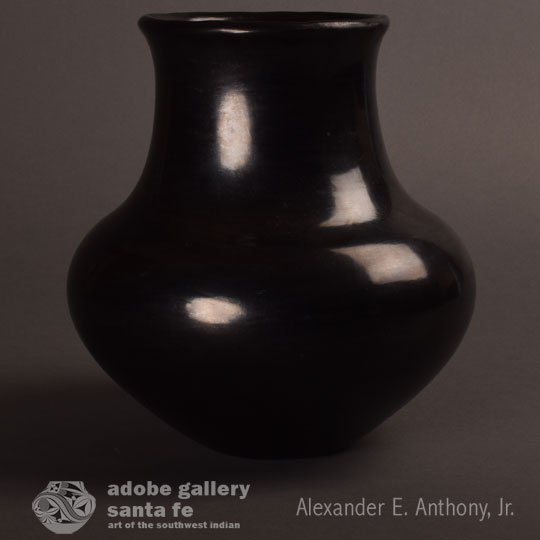
Speaking of near-perfect, here's a wonderful example that comes from a little bit later than the Laguna jar. This jar was made by the great Maria Martinez of San Ildefonso Pueblo. I appreciate the fine designs painted by her family members/collaborators, but I seem to be drawn toward unpainted pieces like this one. It's about as elegant as a piece of clay could be. The polish is perfect, and the shape is beautiful. I think this is a truly special Maria jar with a powerful presence. It has caught my eye repeatedly, and I always enjoy having a look at it.
Read more about this Maria Jar
Vote for Adobe Gallery as BEST GALLERY 2019
 We proudly represent and advertise Canyon Road as a number one art destination while visiting Santa Fe. This year, Adobe Gallery is on the “Best of Santa Fe” ballot for the Santa Fe Reporter contest. We are the sole representative of Canyon Road. Please support and vote for Canyon Road by voting for Adobe Gallery.
We proudly represent and advertise Canyon Road as a number one art destination while visiting Santa Fe. This year, Adobe Gallery is on the “Best of Santa Fe” ballot for the Santa Fe Reporter contest. We are the sole representative of Canyon Road. Please support and vote for Canyon Road by voting for Adobe Gallery.
How to vote (through end of May 2019):
The direct link is here: Vote in the BEST OF SANTA FE contest
Or on the Santa Fe Reporter website Sfreporter.com look for
-
BEST OF SANTA FE at the top of the page
-
Choose Arts & Entertainment category
-
Scroll down to BEST GALLERY and vote for Adobe Gallery
Acoma Pueblo Wedding Vase with Bird Design by Jessie Garcia - C4137B
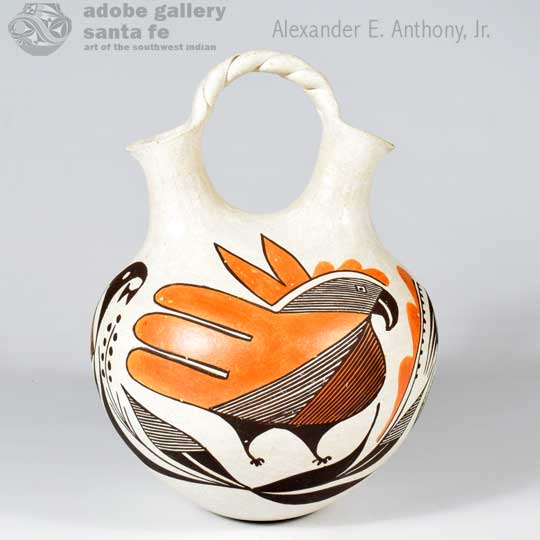 Jessie Garcia took the Acoma parrot to a new level in this wedding vessel. The outline of the bird is more artsy than most parrots by other artists. Her use of fine lines in three areas of the bird's body adds a degree of sophistication not seen in other potter's birds. The birds on the sides of the vessel are also creatively unique.
Jessie Garcia took the Acoma parrot to a new level in this wedding vessel. The outline of the bird is more artsy than most parrots by other artists. Her use of fine lines in three areas of the bird's body adds a degree of sophistication not seen in other potter's birds. The birds on the sides of the vessel are also creatively unique.
Jessie Garcia was considered by Rick Dillingham (author of Acoma & Laguna Pottery-see link below) as one of the three most important 20th century potters from Acoma Pueblo, along with Lucy Lewis and Marie Z. Chino. She was the mother of Anita Lowden and Stella Shutiva and the mother-in-law of Sarah Garcia, all three of whom are recognized as outstanding potters. In 1941, Museum of New Mexico director Kenneth Chapman donated a Jessie Garcia seed jar to the Indian Arts Fund. The Indian Arts Fund purchased a Jessie Garcia bowl from Mrs. William J. Lippincott, and then, in 1966, the Indian Arts Fund made a direct purchase of a bowl from Jessie at Santa Fe Indian Market. These acquisitions indicate the esteem that the Indian Arts Fund had for the work of this potter.
#adobegallery #SouthwestIndianPottery #AcomaPueblo #AcomaPottery #PuebloPottery #SouthwestIndianArt #SantaFePottery #FinePuebloPottery #ContemporaryPottery
Hopi Pueblo Wupamo Katsina - Kachina Doll - C4126C1
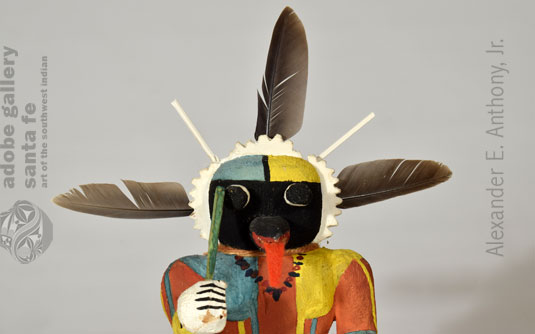 Wupamo appears on all three mesas as a guard, and the whips that he carries are for use on the unwary. Usually he may be found during the Powamu procession circling out from the sides or swinging in at the rear to spur the laggards. He moves a little more quickly than Wuyak-kuita but just as surely.
Wupamo appears on all three mesas as a guard, and the whips that he carries are for use on the unwary. Usually he may be found during the Powamu procession circling out from the sides or swinging in at the rear to spur the laggards. He moves a little more quickly than Wuyak-kuita but just as surely.
On Hopi Pueblo, First Mesa, as one of the Furious Katsinas, he is often led or rather held back by a rope around his waist that is held by a *Koyemsi. He is given to making short furious dashes towards the audience or other katsinas or kiva priests much in the manner of an erratic dog.
In addition to the Powamu he may appear in the Palȍlȍkong or help enforce community work such as spring cleaning.
#adobegallery #HopiPueblo #Katsina #Kachina #Doll #SouthwestIndianArt #PuebloArt #SantaFeNM #NativeAmericanArts
Hopi Pueblo Talavai - Morning Katsina Doll - C4126C2
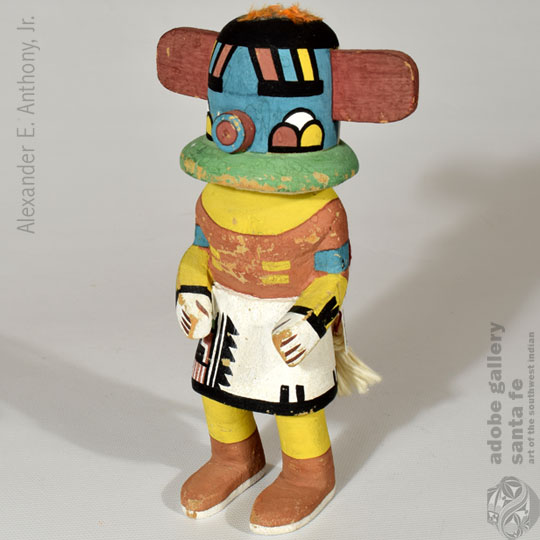 The Talavai or Morning Katsina formerly appeared in pairs on the rooftops and sang songs, waking the people in their village. During the day they would dance with the other katsinas whom they led and prompted in the singing. This role is no longer used in any of the villages. They still appear with the other katsinas in the PowamuCeremony and are most often standing in a set to one side of the main movement of the procession. Occasionally they sing as they stand holding their spruce trees and ringing their bells.
The Talavai or Morning Katsina formerly appeared in pairs on the rooftops and sang songs, waking the people in their village. During the day they would dance with the other katsinas whom they led and prompted in the singing. This role is no longer used in any of the villages. They still appear with the other katsinas in the PowamuCeremony and are most often standing in a set to one side of the main movement of the procession. Occasionally they sing as they stand holding their spruce trees and ringing their bells.
The specific name of this katsina is also the generic name of a group of katsinas that appear at dawn on the last day of the Bean Dance (or the Powamu Ceremony) and give presents and bean sprouts to the children of the village. This latter group, referred to as Talavai Katsinas, may include Huhuwa, Ma'alo, Talavai, Hemis and many others to include the Morning.
#adobegallery #HopiPueblo #Katsina #Kachina #Doll #SouthwestIndianArt #PuebloArt #SantaFeNM #NativeAmericanArts
Cochiti Pueblo Early Singing Mother Figurine with One Child by Helen Cordero - C4123A
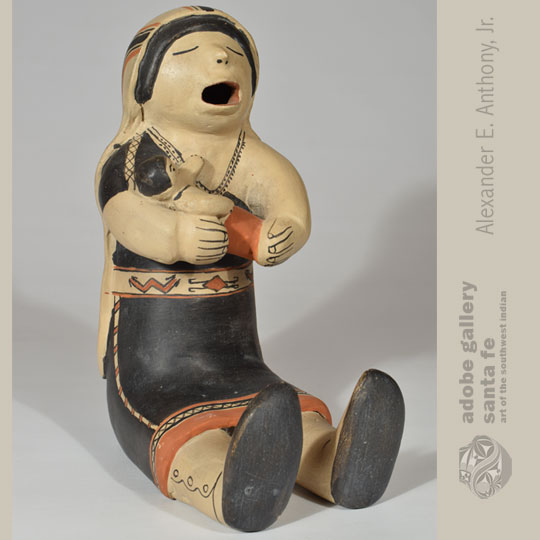 Helen Cordero was truly an original artist. Unable to fashion pottery vessels in a manner with which she could be satisfied, she changed her course to figurative pottery, rather than give up altogether. Little did she know that she was starting a new tradition in pueblo pottery production.
Helen Cordero was truly an original artist. Unable to fashion pottery vessels in a manner with which she could be satisfied, she changed her course to figurative pottery, rather than give up altogether. Little did she know that she was starting a new tradition in pueblo pottery production.
Cordero is now famous for creating the pueblo storyteller figurine-a male figurine with a number of children climbing over him. She stated that her grandfather was a storyteller and that is where she got the idea from. In addition to male storyteller figurines, Cordero also made female figurines, similar to the storyteller, but she called them "singing mothers." She only made storytellers as male. Any of her female figurines are designated differently.
This figurine is one of her "singing mothers" holding a single child. She is dressed in the traditional pueblo manta which rides over one shoulder and under the other. Her waist is tied with a belt that hangs down her left side and her manta is fringed at the hem. She is wearing the traditional leather moccasins with leg wraps. Over her head she is wearing a striped shawl. The adult's eyes are closed and mouth open as she sings to the baby, a tradition that Cordero followed throughout her storyteller career.
#adobegallery #SouthwestIndianPottery #CochitiPueblo #CochitiPottery #PuebloPottery #SouthwestIndianArt #SantaFePottery #FinePuebloPottery #ContemporaryPottery #HelenCordero
Kewa - Santo Domingo Pueblo Historic Large Dough Bowl - C4119A
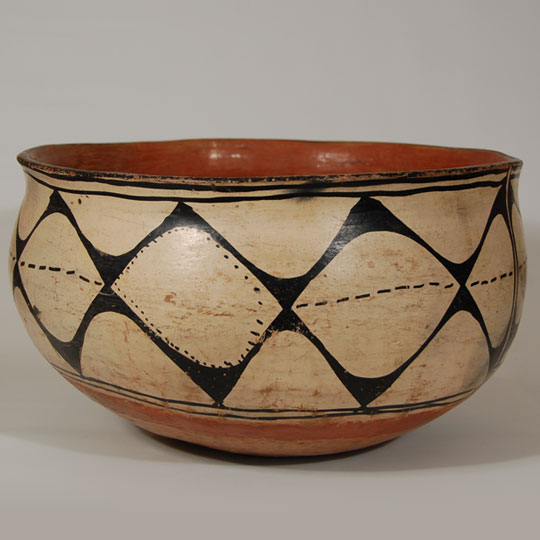 Well-crafted and beautifully-decorated pottery has always been part of the pueblo aesthetic. It was not until the late 19th century that potters started adhering to the unfamiliar tastes of the Western eye. It was of necessity to do this in order to make a sale. This has not changed even today. Potters produce what they know will sell to the non-Indian market.
Well-crafted and beautifully-decorated pottery has always been part of the pueblo aesthetic. It was not until the late 19th century that potters started adhering to the unfamiliar tastes of the Western eye. It was of necessity to do this in order to make a sale. This has not changed even today. Potters produce what they know will sell to the non-Indian market.
This dough bowl, however, speaks loudly of the pueblo aesthetic. It was made for, designed by and used by a pueblo potter. It was made in the vessel shape that was needed for a particular use and designed with a traditional Kewa Pueblo design which could have been passed down in the same family of potters for decades. It is because of these reasons that this bowl becomes such a collectible treasure. It was beautifully shaped and expertly painted. It is possible that it may have been used for several decades before leaving the pueblo.
#adobegallery #SouthwestIndianPottery #KewaPueblo #KewaPottery #SantoDomingoPueblo #PuebloPottery #FinePuebloPottery #HistoricPottery
San Ildefonso Polychrome Globular Olla, circa 1890 by Marianita Roybal - C4119B
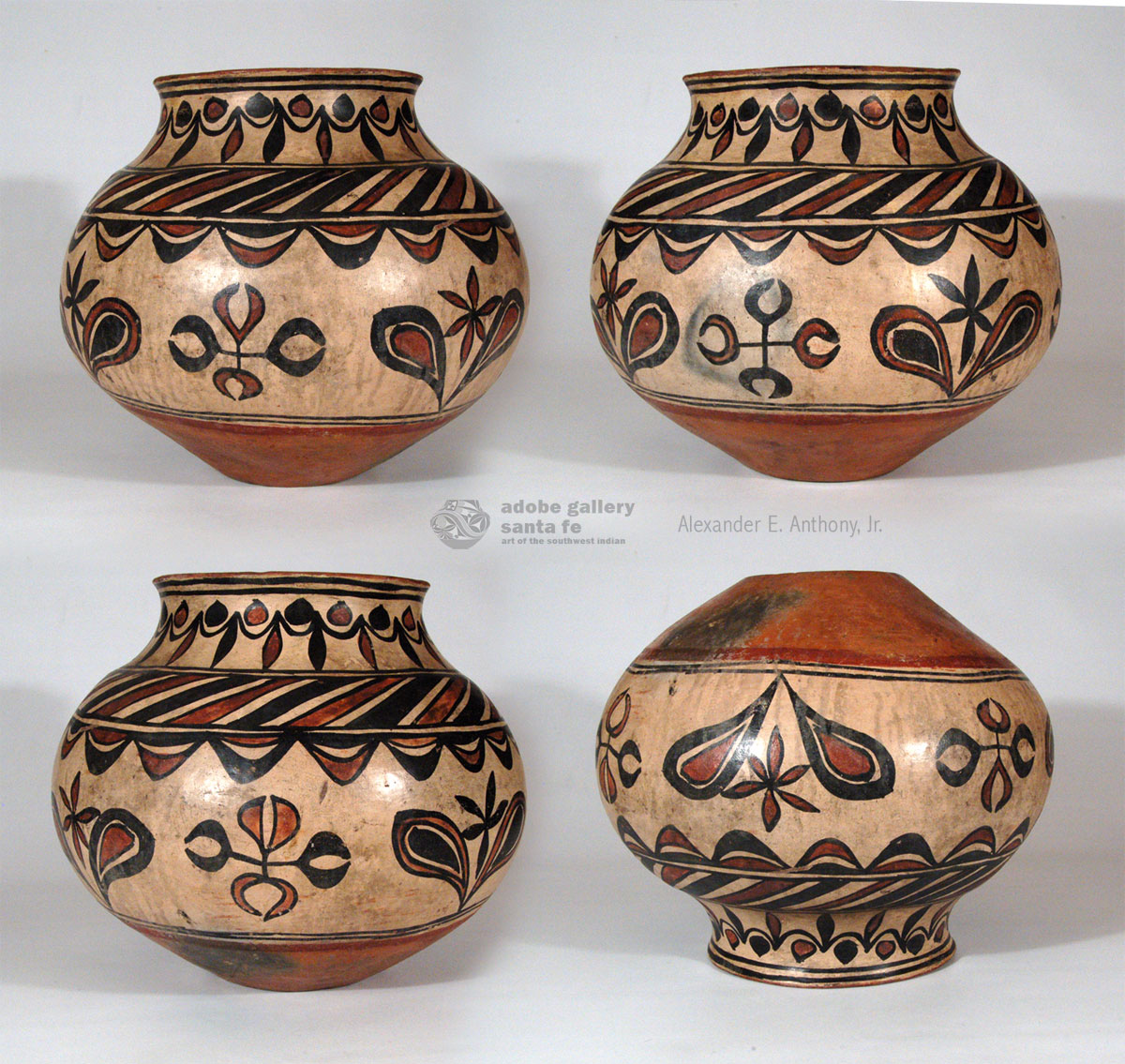 This historic pottery jar is an old friend who has returned to the gallery. We sold it in 1999 to a client to whom we stated that it was attributed to Marianita Roybal of San Ildefonso Pueblo. Marianita was an active potter from about 1860 to 1910. "Her jars were mostly with orange rims, designs around the neck, and a principal design of repeated forms around the middle. Her bases were often orange. Her jars, in the 1880s, were rounded with a 'full belly' and graceful, short necked rims. Her later jars would become more compressed with the belly of the jars pushed down and the necks more elongated." - Schaaf 2000
This historic pottery jar is an old friend who has returned to the gallery. We sold it in 1999 to a client to whom we stated that it was attributed to Marianita Roybal of San Ildefonso Pueblo. Marianita was an active potter from about 1860 to 1910. "Her jars were mostly with orange rims, designs around the neck, and a principal design of repeated forms around the middle. Her bases were often orange. Her jars, in the 1880s, were rounded with a 'full belly' and graceful, short necked rims. Her later jars would become more compressed with the belly of the jars pushed down and the necks more elongated." - Schaaf 2000
Marianita collaborated with different pottery painters-Maximiliana "Anna" Montoya, elder sister of Maria Martinez; Crescencio Martinez (1879-1918); Marianita's son, Ignacio Roybal; and her grandson, Joe Aguilar. There may have been others, such as Florentino Montoya (1858-1918).
#adobegallery #SouthwestIndianPottery #SanIldefonsoPueblo #SanIldefonsoPottery #PuebloPottery #FinePuebloPottery #HistoricPottery #MarianitaRoybal
Historic Laguna Pueblo Four Color Small Olla - C4119G
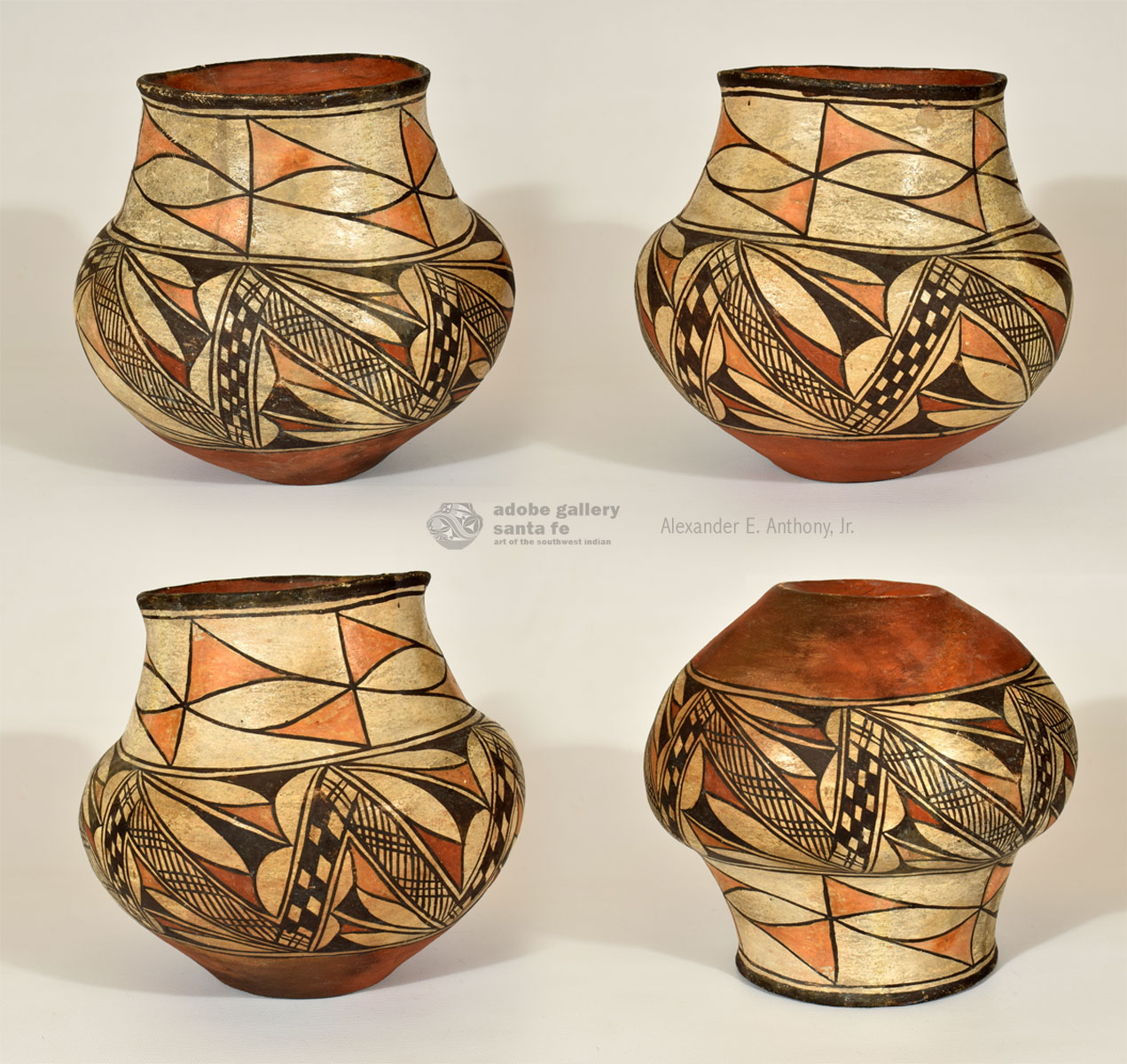 It was not unusual for potters to decorate with four colors of pigment or slip in the late 1800s, but it was rare to see the use of four colors in the earlier twentieth century. Perhaps, the extra work in applying a fourth color was not prudent because tourists were not interested in paying more for a souvenir than necessary. So, why should a potter expend the extra time in decorating a jar if something simpler would suffice?
It was not unusual for potters to decorate with four colors of pigment or slip in the late 1800s, but it was rare to see the use of four colors in the earlier twentieth century. Perhaps, the extra work in applying a fourth color was not prudent because tourists were not interested in paying more for a souvenir than necessary. So, why should a potter expend the extra time in decorating a jar if something simpler would suffice?
This small jar was a labor of love for the potter. She chose to spend time laying out and painting an exquisite masterpiece of fine craftsmanship. The zigzag black-on-white bars encircling the body are stylistically those used by potters at Laguna during the early 20th century. Not only did they often use such bars, they also used checkerboard designs. The simple design surrounding the neck of the jar is typical of Laguna potters too. An Acoma potter would have filled in the white area with more designs.
#adobegallery #SouthwestIndianPottery #LagunaPueblo #LagunaPottery #PuebloPottery #SouthwestIndianArt #FinePuebloPottery #HistoricPottery
Black on Black Seed Jar with Sienna Medallions by Grace Medicine Flower - C4122B
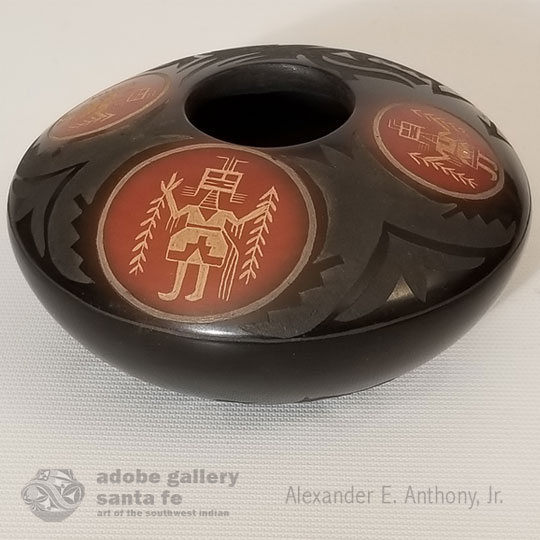 Grace Medicine Flower and her father, Camilio Tafoya, collaborated on pottery for a number of years. Grace says she actually started working with her dad when she was just a child. She started making very traditional Santa Clara Pueblo carved ware but eventually developed her contemporary style of sgraffito carving. Camilio, too, started with traditional carved ware but specialized in very large pieces.
Grace Medicine Flower and her father, Camilio Tafoya, collaborated on pottery for a number of years. Grace says she actually started working with her dad when she was just a child. She started making very traditional Santa Clara Pueblo carved ware but eventually developed her contemporary style of sgraffito carving. Camilio, too, started with traditional carved ware but specialized in very large pieces.
This small seed jar is typical of the style Grace and Camilio made in the 1970s and 1980s. It is one of their most sought-after styles. The body of the vessel is a very highly polished black. The matte black design is just slightly carved into the clay body. The three sienna medallions each feature a Navajo reigious Yei figure of the Diné. The matte design on the top surface is a stylized Avanyu water serpent.
#adobegallery #SouthwestIndianPottery #SantaClaraPueblo #SantaClaraPottery #PuebloPottery #SouthwestIndianArt #SantaFePottery #FinePuebloPottery #ContemporaryPottery #GraceMedicineFlower
Polished Black Santa Clara Pueblo Bowl by Nathan Youngblood - C4114A
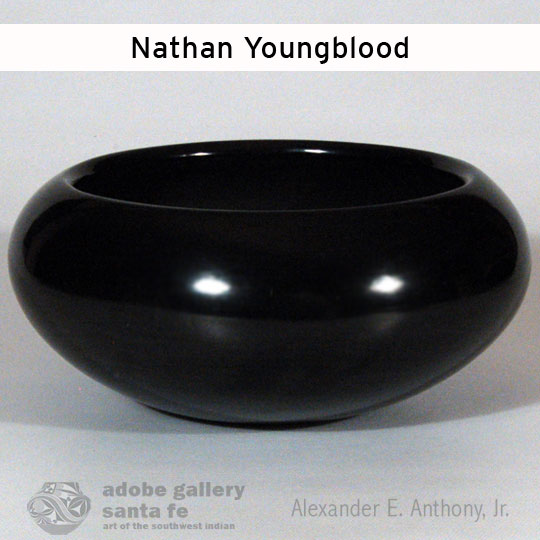 Nathan Youngblood (1954- ) Deer Path chose to leave this bowl void of decoration and to let the beautiful dark black burnishing serve that purpose. There is a beauty in such a vessel shape, in the dark black mirror reflection, and in the burnishing to a high luster.
Nathan Youngblood (1954- ) Deer Path chose to leave this bowl void of decoration and to let the beautiful dark black burnishing serve that purpose. There is a beauty in such a vessel shape, in the dark black mirror reflection, and in the burnishing to a high luster.
The jar is signed with the name of the artist but there is no date of when it was made. It is quite likely that it dates to the late 1970s, as that was a period when Nathan produced what may be called understated pottery-understated not being a negative term but a term of accomplishment.
#adobegallery #SouthwestIndianPottery #SantaClaraPueblo #SantaClaraPottery #PuebloPottery #SouthwestIndianArt #SantaFePottery #FinePuebloPottery #ContemporaryPottery #NathanYoungblood
Cochiti Pueblo Very Large Storyteller Figurine by Dorothy Trujillo - C4094A
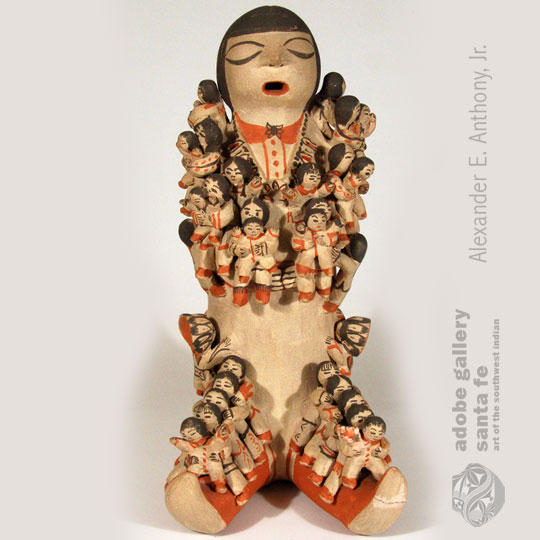 Dorothy Trujillo was one of the early potters to make storyteller figurines. She was from a family of outstanding potters. Her sisters, Mary E. Toya (b.1934), Marie Edna Coriz (b.1946), Alma Loretto Concha Maestas (b.1941), Fannie Loretto Wall (b.1953), and Lenora Lupe Lucero (b.1943), are famous potters as well. Interestingly, her sisters also married out of their native pueblo and moved to the pueblo of their spouses.
Dorothy Trujillo was one of the early potters to make storyteller figurines. She was from a family of outstanding potters. Her sisters, Mary E. Toya (b.1934), Marie Edna Coriz (b.1946), Alma Loretto Concha Maestas (b.1941), Fannie Loretto Wall (b.1953), and Lenora Lupe Lucero (b.1943), are famous potters as well. Interestingly, her sisters also married out of their native pueblo and moved to the pueblo of their spouses.
In true Cochiti Pueblo tradition, Dorothy made her figurine with eyes closed and mouth open. The closed eyes represent "thought" and the open mouth represents "storytelling." The adult figurine is beautifully painted with a design on the back and wearing a squash blossom necklace. There are 30 children spread over the adult figure. Two of the children are wearing Plains Indian headdresses. The figurine is signed with the artist's name.
#adobegallery #SouthwestIndianPottery #CochitiPueblo #CochitiPottery #PuebloPottery #SouthwestIndianArt #SantaFePottery #FinePuebloPottery #ContemporaryPottery #DorothyTrujillo
Historic Hopi Polacca Polychrome Bowl with Hanging Lug - C4104E
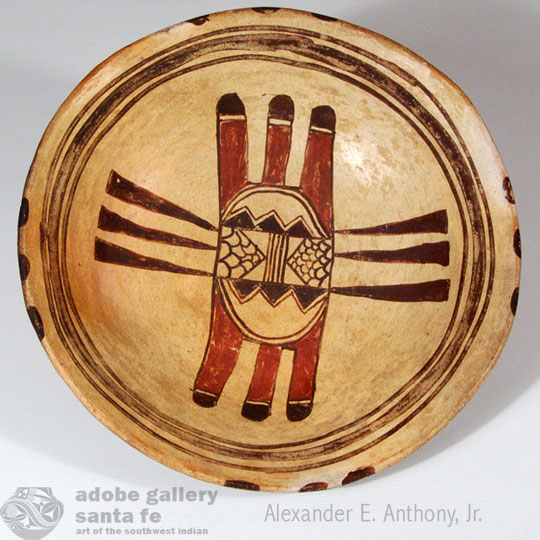 The Hopi call their ancestors Hisatsinam, "People of Long Ago." Most others refer to them as Anasazi. The Hopi ancestors were making pottery as long ago as A.D. 700. They made black-on-white, black-on-red, and, eventually, Polychrome. The Polychrome wares started around 1740, became the predominant utilitarian style around 1800, and continued being used until the 1890s, being known as Polacca Polychrome.
The Hopi call their ancestors Hisatsinam, "People of Long Ago." Most others refer to them as Anasazi. The Hopi ancestors were making pottery as long ago as A.D. 700. They made black-on-white, black-on-red, and, eventually, Polychrome. The Polychrome wares started around 1740, became the predominant utilitarian style around 1800, and continued being used until the 1890s, being known as Polacca Polychrome.
Collectors developed an interest in pottery from the Hopi Mesas in the late 1800s, resulting in a revival period for Hopi pottery, spearheaded by Nampeyo and other First Mesa potters. Early pottery of this period by Nampeyo was in the Polacca Polychrome style, prior to her revival of Sikyatki-inspired pottery.
This Polacca Polychrome bowl is most certainly one made in the 1890s as an item intended for sale. It has a lug on the back side from which it can be hung on a wall, something for which a Hopi would have no use. The design features elements of rain, rain clouds, and tail feathers.
#adobegallery #SouthwestIndianPottery #HopiPueblo #HopiPottery #PuebloPottery #SouthwestIndianArt #FinePuebloPottery #HistoricPottery #IndianMarket#sfim2018
Black on White Design Acoma Pueblo Jar by Mary Histia - C4113
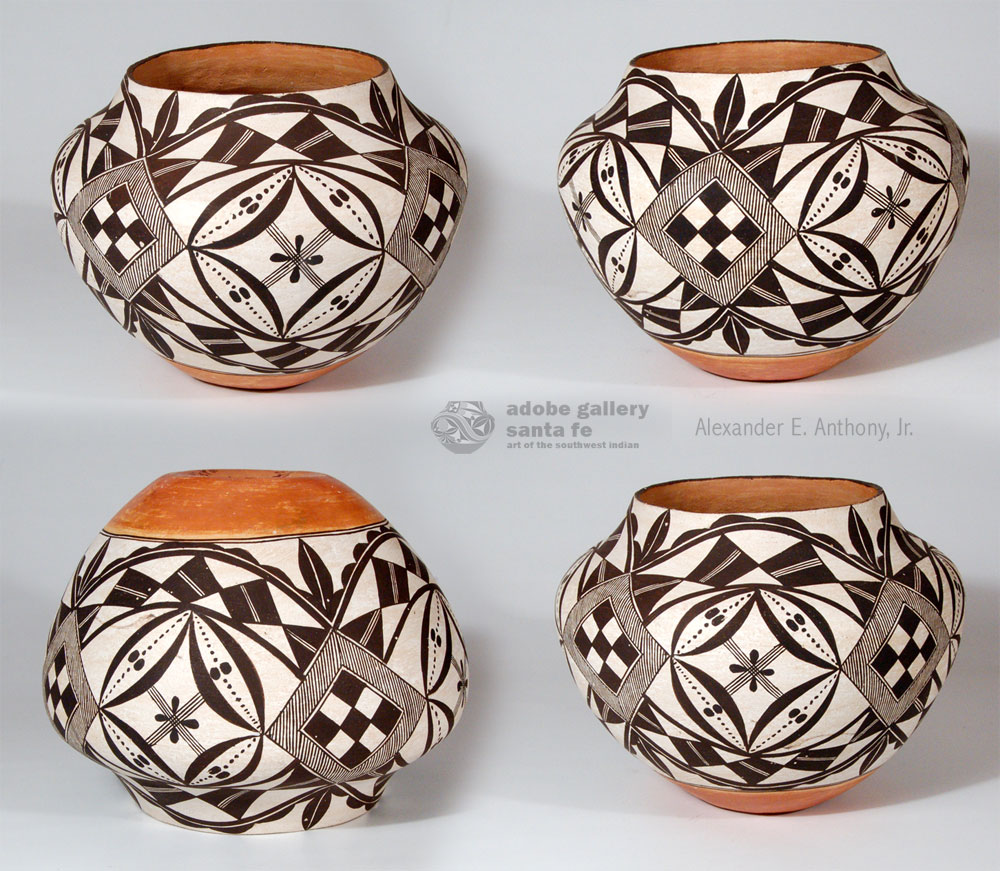 This Acoma jar by Mary Histia was a gift from the potter to Maureen Grammer of Albuquerque in 1966. Grammer, a resident of Albuquerque since 1926 passed away in 2004. She had been a teacher in the Albuquerque Public Schools until her retirement. She had obtained BA and MA degrees from the University of New Mexico. After her retirement, she concentrated on working in the fine arts and Indian arts appraisal business and on writing for magazines.
This Acoma jar by Mary Histia was a gift from the potter to Maureen Grammer of Albuquerque in 1966. Grammer, a resident of Albuquerque since 1926 passed away in 2004. She had been a teacher in the Albuquerque Public Schools until her retirement. She had obtained BA and MA degrees from the University of New Mexico. After her retirement, she concentrated on working in the fine arts and Indian arts appraisal business and on writing for magazines.
Mrs. Grammer was a well-known student of American Indian arts and was a noted appraiser of Indian arts for decades. She identified unsigned works by Native artists and was accepted as a knowledgeable expert on the subject. It is not unusual to see statements saying "Maurine Grammer said . . ." or "according to Maurine Grammer . . ." and such statements are accepted as fact.
#adobegallery #SouthwestIndianPottery #AcomaPueblo #AcomaPottery #PuebloPottery #SouthwestIndianArt #FinePuebloPottery #HistoricPottery #IndianMarket#sfim2018 #MaryHistia
Acoma Domed Polychrome Pottery Miniature Vessel by Carolyn Concho - 26106A
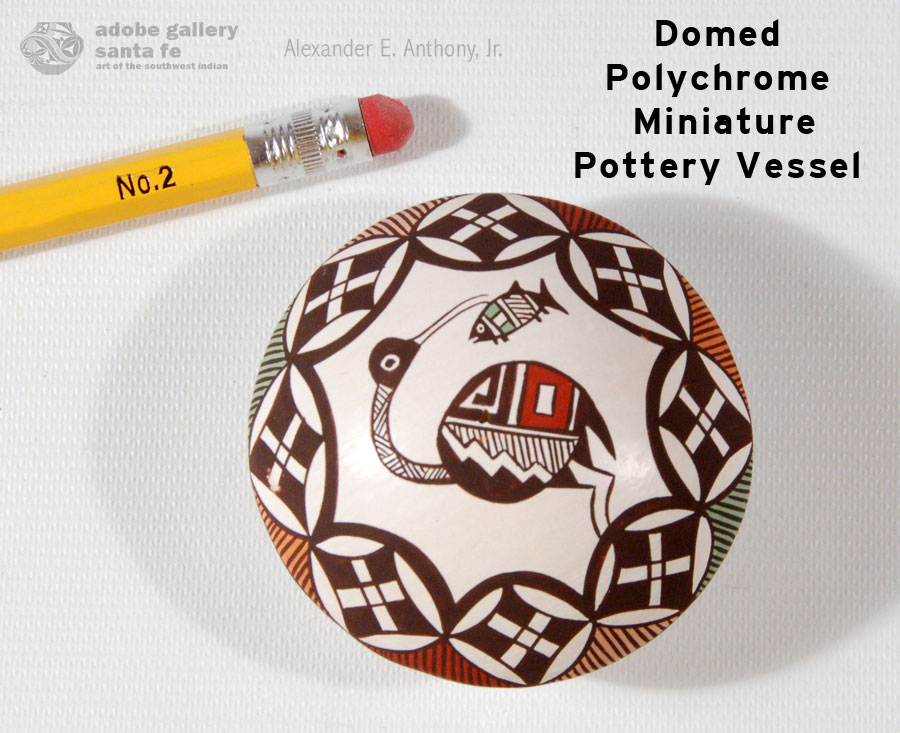 Carolyn Concho is the daughter of Katherine Lewis of Acoma Pueblo and sister of Rebecca Lucario, Marilyn Henderson Ray, Judy Lewis, Diane Lewis, & Bernard Lewis. She has been an active potter since circa 1984. Carolyn was born September 15, 1961 at the village of Acomita on the Acoma Reservation. She has won numerous awards at Santa Fe Indian Market, Heard Museum, and New Mexico State Fair. She has sold to museums and collectors since 1984.
Carolyn Concho is the daughter of Katherine Lewis of Acoma Pueblo and sister of Rebecca Lucario, Marilyn Henderson Ray, Judy Lewis, Diane Lewis, & Bernard Lewis. She has been an active potter since circa 1984. Carolyn was born September 15, 1961 at the village of Acomita on the Acoma Reservation. She has won numerous awards at Santa Fe Indian Market, Heard Museum, and New Mexico State Fair. She has sold to museums and collectors since 1984.
This small seed jar was executed in five pigment colors-white, dark brown, green, orange and red pigments. The main design on top of the dome is a Mimbres crane that has just captured a fish. Surrounding that are diamonds in brown pigment interspersed by triangles in color with fine parallel lines. The bottom is signed C. Concho Acoma, N.M.
#adobegallery #SouthwestIndianPottery #AcomaPueblo #AcomaPottery #PuebloPottery #SouthwestIndianArt #SantaFePottery #FinePuebloPottery #ContemporaryPottery #sfim2018 #CarolynConcho
Santa Clara Pueblo Black Carved Globular Jar by Jennie Trammel - C4111D
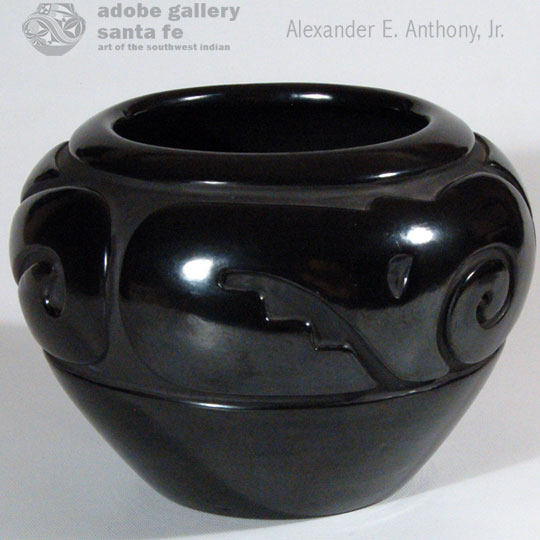 As we have stated before, Jennie Trammel was an amazing potter, producing some of the most beautiful pueblo pottery ever. Unfortunately, she made fewer pottery items than any of the other daughters of Margaret Tafoya. She had a full-time job away from Santa Clara Pueblo and had little time for making pottery. Interestingly, she was absolutely a phenomenal potter and produced the most beautiful carved wares of the twentieth century.
As we have stated before, Jennie Trammel was an amazing potter, producing some of the most beautiful pueblo pottery ever. Unfortunately, she made fewer pottery items than any of the other daughters of Margaret Tafoya. She had a full-time job away from Santa Clara Pueblo and had little time for making pottery. Interestingly, she was absolutely a phenomenal potter and produced the most beautiful carved wares of the twentieth century.
At first glance, one might overlook that the carved outline of this jar features the revered Avanyu, or water serpent, often seen on Santa Clara and San Ildefonso potteries. The artist modernized the serpent somewhat so it is not obviously apparent that it is an Avanyu. The lightning from the Avanyu's mouth has been curled around rather than protruding straight out.
#adobegallery #SouthwestIndianPottery #SantaClaraPueblo #SantaClaraPottery #PuebloPottery #SouthwestIndianArt #SantaFePottery #FinePuebloPottery #ContemporaryPottery #sfim2018 #JennieTrammel

